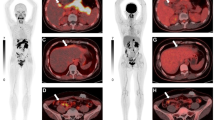Abstract.
In developing iodine-123-labelled amino acid derivatives for imaging cerebral gliomas by single-photon emission tomography (SPET), we compared p-[123I]iodo-l-phenylalanine (IPA), l-[123I]iodo-1,2,3,4-tetrahydro-7-hydroxyisoquinoline-3-carboxylic acid (ITIC) and l-3-[123I]iodo-α-methyltyrosine (IMT) with regard to their uptake in human glioblastoma T99 and T3868 cells, and thereafter studied the mechanisms promoting the cellular uptake. The potential of the 123I-iodinated agents for use as SPET radiopharmaceuticals was evaluated in healthy experimental rats as well as in rats with stereotactically implanted C6 gliomas. The radiopharmaceutical uptake into glioblastoma cells was rapid, temperature and pH dependent, and linear during the first 5 min. Equilibrium was reached after 15–20 min, except in the case of ITIC, the initial uptake of which gradually decreased from 15 min onwards. The radioactivity concentration in glioma cells following 30-min incubation at 37°C (pH 7.4) varied from 11% to 35% of the total activity per million cells (ITIC < IMT ≤ IPA). Competitive inhibition experiments using α-(methylamino)-isobutyric acid and 2-amino-2-norbornane-carboxylic acid, known as specific substrates for systems A and L, respectively, as well as representative amino acids preferentially transported by system ASC, indicated that IPA, like IMT, is predominantly mediated by the L and ASC transport systems, while no significant involvement of the A transport system could be demonstrated. By contrast, none of the three principal neutral amino acid transport systems (A, L and ASC) appear to be substantially involved in the uptake of ITIC into glioblastoma cells. Analysis of uptake under conditions that change the cell membrane potential, i.e. in high K+ medium, showed that the membrane potential plays an important role in ITIC uptake. Alteration of the mitochondrial activity by means of valinomycin or nigericin induces a slight increase or decrease in the radiopharmaceutical uptake, suggesting a minor contribution of the mitochondria in the uptake. IPA, IMT and ITIC passed the blood-brain barrier, and thereafter showed efflux from the brain. The radioactivity concentration in healthy rat brain 15 min following intravenous injection varied from 0.07% (ITIC) to 0.27% ID/g (IPA). In comparison, the brain uptake in the stereotactically implanted C6 glioma rats was substantially higher (up to 1.10% ID/g 15 min p.i.), with tumour-to-background ratios greater than 4. These data indicate that IPA and ITIC, like IMT, exhibit interesting biological characteristics which hold promise for in vivo brain tumour investigations by SPET.
Similar content being viewed by others
Author information
Authors and Affiliations
Additional information
Received 21 March and in revised form 15 May 2000
Electronic Publication
Rights and permissions
About this article
Cite this article
Samnick, S., Richter, S., Romeike, B. et al. Investigation of iodine-123-labelled amino acid derivatives for imaging cerebral gliomas: uptake in human glioma cells and evaluation in stereotactically implanted C6 glioma rats. Eur J Nucl Med 27, 1543–1551 (2000). https://doi.org/10.1007/s002590000310
Published:
Issue Date:
DOI: https://doi.org/10.1007/s002590000310




